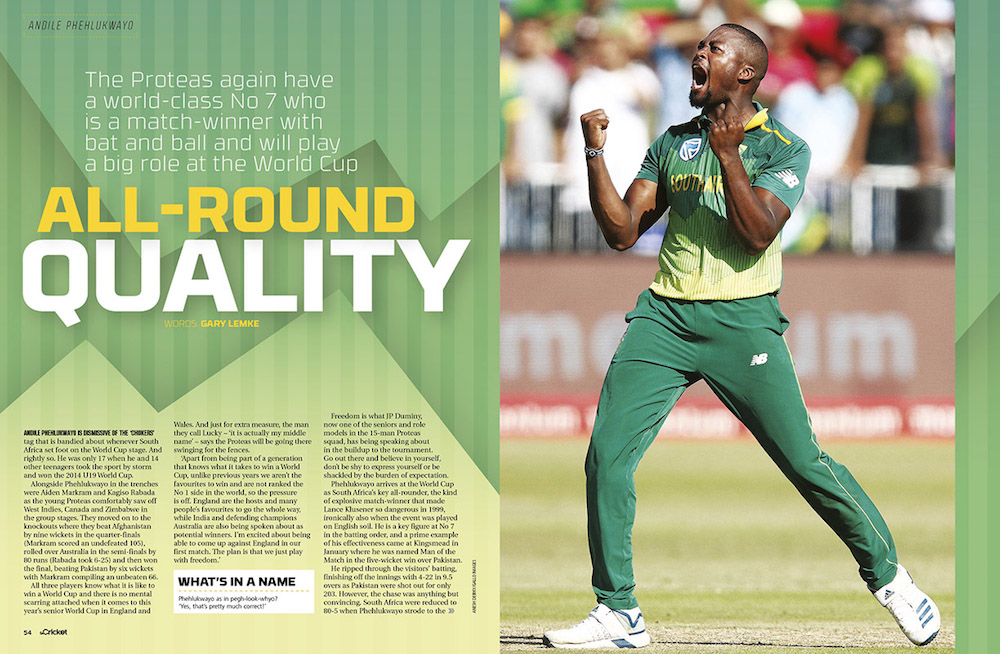The Proteas again have a world-class No 7 who is a match-winner with bat and ball, and will play a big role at the World Cup, writes GARY LEMKE.
Andile Phehlukwayo is dismissive of the ‘chokers’ tag that is bandied about whenever South Africa take to the World Cup stage. And rightly so. He was only 17 when he and 15 other teenagers took the sport by storm and won the 2014 U19 World Cup.
Alongside Phehlukwayo in the trenches were Aiden Markram and Kagiso Rabada as the young Proteas comfortably saw off West Indies, Zimbabwe and Canada in the group stages, before moving to the knockouts where they beat Afghanistan by nine wickets in the quarter-finals (Markram scored an undefeated 105). They then rolled over Australia in the semi-finals by 80 runs (Rabada took 6-25) and took the final, beating Pakistan by six wickets with Markram compiling an unbeaten 66.
All three players know what it is like to win a World Cup, and they bear no mental scars when it comes to this year’s senior World Cup in England and Wales. And just for extra measure, the man they call Lucky – ‘it is actually my middle name’ – Phehlukwayo says the Proteas will be going in there, swinging for the fences.
‘Apart from being part of a generation that knows what it takes to win a World Cup, unlike previous years we won’t be arriving in England as the favourites to win, and are not ranked the No 1 side in the world. England are the hosts and many people’s favourites to go the whole way, while India and defending champions Australia are also being spoken about as potential winners. I’m excited about being able to come up against England in our first match. We are not the favourites, so the pressure is off. The plan is that we just want to play with freedom.’
Freedom is what JP Duminy, now one of the seniors and role models in the 15-man Proteas squad, has been speaking about in the buildup to the tournament. Go out there and believe in yourself, don’t be shy to express yourself or being shackled by the burden of expectation.
Phehlukwayo arrives at the World Cup as South Africa’s key all-rounder, the kind of explosive match-winner that made Lance Klusener so dangerous in 1999, ironically also when the event was played on English soil. He is a key figure at No 7 in the batting order, and a prime example of his effectiveness came at Kingsmead in February where he was named Man of the Match in the five-wicket win over Pakistan.
There, he ripped through the Pakistan batting, finishing off the innings with 4-22 in 9.5 overs as the visitors were shot out for only 203. However, the chase was anything but convincing. South Africa were reduced to 80-5 when Phehlukwayo strode to the crease, joining Rassie van der Dussen out in the middle with 124 runs still needed, and only the bowlers (Rabada, Dane Paterson, Tabraiz Shamsi and Duanne Olivier) still to come.
Phehlukwayo, who’d also taken two catches in the field, turned aggressor, and with a bit of ‘luck’ along the way was there at the end with 69 off 80 balls as he and Van der Dussen took South Africa home with 48 deliveries remaining.
‘I’d got a role to play,’ said Phehlukwayo. ‘I was a bit nervous to begin with when I batted. Rassie did a good job of calming me down. I stuck to my plans and played with intensity. There was some good chat. Shadab was one of the hardest to pick. At the end of the day, it was good cricket. I’m a positive person, I really like scoring boundaries and making runs.’
It’s that kind of attitude which is going to be all important to the South African cause at this World Cup. Apart from his aggression with the bat in that No 7 position, it’s with ball in hand that the 23-year-old has made a big impression in the green and gold since his debut against Ireland in 2016. And he has been earmarked as the player who is likely to be bowling ‘at the death’ in the upcoming tournament when the pressure is on and the batsmen are looking to clear the ball over the ropes.
Phehlukwayo reckons it’s a role he is entirely comfortable with. ‘I like the challenge of death bowling, that edge of uncertainty,’ he says. ‘By preparing well I know I can succeed. And that makes it more exciting than nerve-racking. Also, not everyone is able to bowl at the death, so I like to be able to be the one to take the ball when it counts the most.’
One of his bowling strengths is the number of variable deliveries he has up his sleeve; the slow bouncer, the full wide delivery, the heavy ball, the yorker – as well as the ball that has had many commentators around the world excited, the so-called knuckle delivery.
How does Phehlukwayo prepare for bowling at the back of an innings, should he – as commentators have asked – bowl more ‘stock deliveries’ and fewer variables?
‘I don’t overthink things,’ he replies. ‘It all depends on the match conditions, the batsmen at the crease, the wicket and so on. When it comes to the knuckle ball, I knew I needed to learn how to bowl it for different conditions. Also, not a lot of people have it in their arsenal, so I wanted to challenge myself to learn how to bowl it effectively.’
At the 2017 ICC Champions Trophy, Phehlukwayo came up against India for the first time in his career and was on the wrong side of an eight-wicket defeat at The Oval in London. On that occasion he made only four with the bat, being out lbw to Jasprit Bumrah, and then went wicketless as India cantered home with Virat Kohli unbeaten on 76.
Then, in February 2018, the Proteas were handed a 5-1 drubbing in the ODI series which came after a Test series in which South Africa had beaten India, showing just how effective and ruthless the 2011 World Cup winners can be in the 50-over format of the game.
Virat Kohli scored three centuries in that series, including a highest score of an unbeaten 160, and he totalled 558 at an average of 186.00 and a strike rate of 99.46. It was an incredible display of stroke-playing, and it’s hardly surprising that their league encounter at the World Cup, on 5 June at the Rose Bowl in Southampton, is going to be key to shaping the Proteas’ fortunes at the tournament.
It’s also no surprise that Phehlukwayo rates India’s players so highly. ‘I played in that game at The Oval and then in five of the six games at home last year. Kohli is comfortably the most difficult batsman I’ve had to bowl to in my career [43 ODI matches]. He just doesn’t get his shots wrong,’ the South African says.
‘His conversion rate is impressive and he can turn your good balls into one run, which immediately puts the pressure back on you. And in terms of the bowlers I’ve faced, it’s Bumrah. He doesn’t miss his length, has good pace and is just so consistent in the balls he bowls to you.’
Clearly then, that showdown with India is going to be lit, as they say.
However, it’s not just England in the tournament opener, or India, or Australia that present the big challenges at the World Cup. The format of the event requires each of the 10 teams to play each other once, and the top four go into the semi-finals, a format that was used in 1992 when South Africa made its World Cup debut and lost in the semi-finals when rain reduced the target to that ‘22 off 1 ball’ farce.
Phehlukwayo’s role is emphatic. ‘I see myself as an all-rounder, and although I think my batting is improving most rapidly, I work hard on my bowling and fielding in preparation and in the matches. I can’t say I spend X amount of time on my batting, bowling or fielding… I’m an all-rounder and that’s it.’
He also bats left-handed, but bowls right-handed. ‘Both come naturally to me. My stronger arm is my right one, and I use that as my top hand when I’m batting, which makes me a left-handed batsman. It’s the right way do it strength-wise and for co-ordination. I used to play hockey right-handed, but I play golf left-handed too.’
READ: Klusener backs Phehlukwayo at No 8
Ah, golf, a favourite pastime to keep cricketers’ minds off things while ‘on the road’. Does he spill the beans on his golfing ability? ‘I’ve played in the Cricket SA golf day, but my partners on that occasion weren’t too good [laughs], but in terms of having an enjoyable time out there on the course then [Dolphins cricketer] Sibonelo [Sibz] Makhanya is the man.
‘Most importantly, I can beat him, but he’s one helluva competitor and no matter the level of sport, it’s great to compete. I enjoy his company on and off the field and there’s always good banter. He’s a gem of a guy. Another guy who is full of banter and is a lot of fun and cracks jokes, is Eathan Bosch, also with the Dolphins franchise. He is very competitive and is an unbelievable player, what a golfer. He’s a huge talent.’
READ COMPLEAT GOLFER FEATURE: Celebrity: Andile Phehlukwayo
And why does he think cricketers make for good golfers – the likes of Jacques Kallis, Shaun Pollock and Kevin Pietersen are extremely talented? ‘It’s probably the motion of the swing and the way we hit through the ball, the timing at the point of impact and always a follow-through. Obviously, there are big differences. As cricketers, we keep our elbows nicely tucked in when getting reading to hit the ball and we hit it inside-out a lot, whereas in golf the elbows aren’t tucked in and one hits it from the outside-in as you go through the ball and then extend through the connection. But it all starts with good co-ordination, being still and having a good ball connection.’
Good ball connection is what South Africa will be looking for with the bat, when Phehlukwayo comes into the middle. We already know what he can do with ball in hand, and with the freedom of expression and knowing what it takes to win a World Cup, the Proteas are equipped with quality personnel as they chase the Holy Grail.
This article was written by Gary Lemke in the latest issue of SA Cricket magazine.
Photo: Abesh Debiky/Gallo Images







